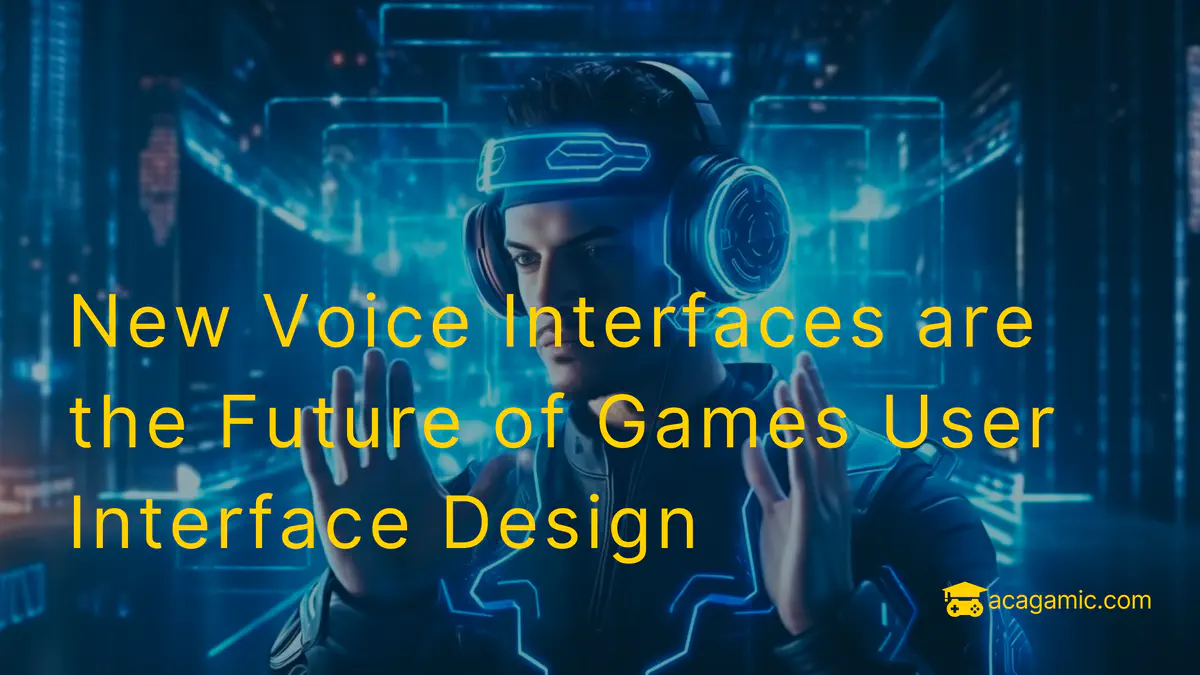New Voice-First Voice Interfaces are the UI Future of User Interface Design
The Acagamic Tip Tuesday #57
 Voice gaming of the future.
Voice gaming of the future.The shift to voice UI in video game user experience (UX) is transformative when it happens because it opens up a new realm of accessibility (think voice assistants like Alexa, Amazon Echo, Cortana, or Siri as an immersive controller or when you enter a room in virtual reality [VR] or augmented reality [AR] on a smartphone), creating even more inclusive and engaging video games. Imagine a world where you don’t need to navigate complex settings menus but rather speak to your game just like you would to a friend (only your friend would articulate via a smart speaker and feel more like a Google assistant). The result? A smoother, more personalized, and more engaging experience thanks to machine learning (in 2022, this would have been voice-first AR and VR).
Unfortunately, most game developers haven’t embraced this transformative approach to the future of user interface (UI) design yet.
Most Developers are Unfamiliar with Conversational and Voice UI Design
People are used to visual interfaces (like touch interfaces or Kinect), which have been the virtual and physical input devices in gaming for decades. But the following reasons also contribute to the hesitation:
- Fear of Technological Inadequacy: The perception that new technology may have design challenges and that the speech recognition may not understand or the computer-generated voice control may not respond accurately
- Lack of Awareness: Many UI designers and developers simply aren’t aware of the potential of voice-controlled interface design.
- Preference for Traditional Interfaces: A self-explanatory familiarity with GUI settings and resistance to change
- Perceived Complexity: The belief that implementing voice UIs is too complex or costly
I believe VUIs can really shape the future and improve accessibility and the gaming experience. Here is how I believe this could happen:
Understand the Next Big Thing is VUI New Technology
The future of voice UIs is not the next big thing; it is already here (beyond mobile and web). Designers need to recognize and help shape the enormous potential of integrating voice and tone of voice into intuitive user interfaces within voice-based games. The help of voice and voice interaction provides an unprecedented level of accessibility, making it possible for gamers with physical restrictions to have an easier time participating in immersive experiences (e.g., imagine game designers connecting it to gesture control, brain signals, mobile apps, touchscreens, smartphones, or physical and digital internet of things [IOT devices]).
Think of virtual worlds in games like “Elite Dangerous,” which has a notoriously difficult-to-navigate game settings menu. It is necessary to wade through numerous layers of menus to modify a particular setting, which can be a time-consuming and tedious process. You could say, “Increase sensitivity,” to a voice user interface, and the task would be completed, which would save you time and reduce your level of frustration.
Acknowledge the Limitations of Text-Based UI Prompts
With a user-friendly Windows CoPilot on the horizon, everyone is talking about the latest developments in a conversational UI within your operating system (simply tell your smart assistant with natural language to do actions like controlling a smart home). However, the overreliance on text prompts in games is where the majority of programmers make their mistake. While this might work with regular applications (where users can interact with or have control over their environment), these prompts have the potential to disrupt the flow of the game and make it difficult to reply to them without human speech, especially when one is deep in the action of the game with a controller.
Text-based prompts, for example, would be highly distracting and time-consuming in multiplayer games with a fast-paced environment because they slow down the action and divert your attention. Voice interfaces, which are analogous to in-game voice chat systems, give way to a method of inputting commands and responding to prompts (creating voices in new sectors like game levels or for different cultures in the game) that is both more natural and more streamlined.
Embrace the Voice-Controlled Games Revolution The Future Holds
If you are a game developer, I think it is time to join the movement toward conversational UIs. My opinion is that this technology is not merely a fleeting fad; rather, it creates new interaction methods for the games of the future.
Voice UIs in gaming improve accessibility, boosting the experience for gamers with disabilities and allowing customization to individual needs. In addition, voice UIs allow for greater personalization of gameplay. No longer will complicated controls or menus be an impediment to a player’s ability to enjoy a game. Every player is able to play in a manner that is customized to their preferences thanks to voice commands.
Also, as food for thought, voice UIs enhance the immersion of a game while also making it easier to play. Players are able to sense a stronger connection to the game’s world and characters when they are able to communicate directly with the game. It also does away with the necessity for sophisticated inputs, making it possible for players to change the game’s settings or take control of it simply by asking.
The introduction of voice user interfaces will fundamentally change the gaming industry by making games more intuitive, personal, and inclusive. They are a reflection of how our relationships with technology and its evolution are progressing.
Imagine players having the ability to have games listen to them, respond to them, and adjust to their preferences, which opens the door to a more meaningful and deeper connection.